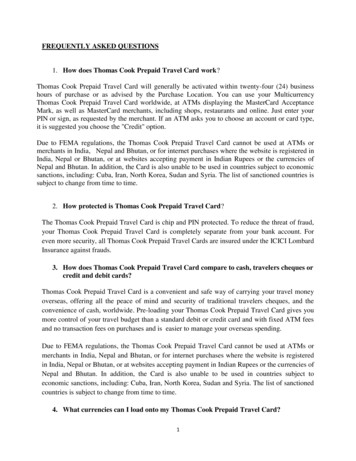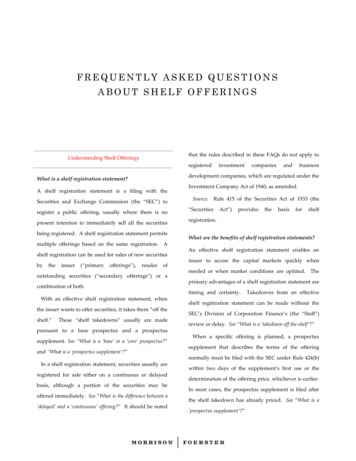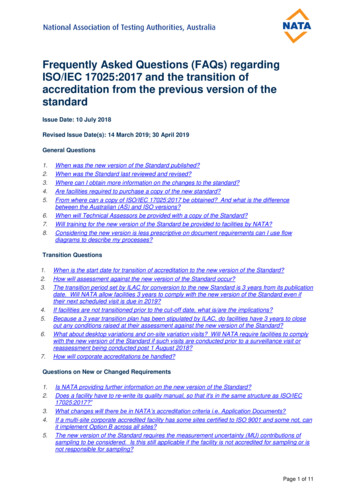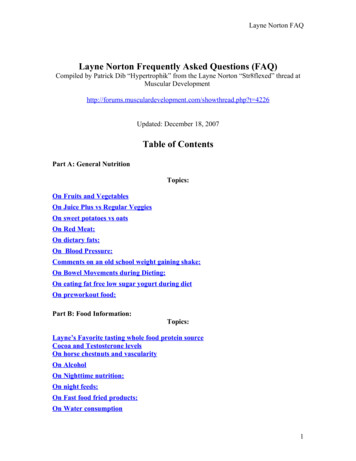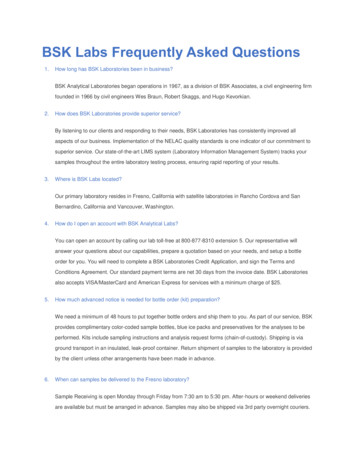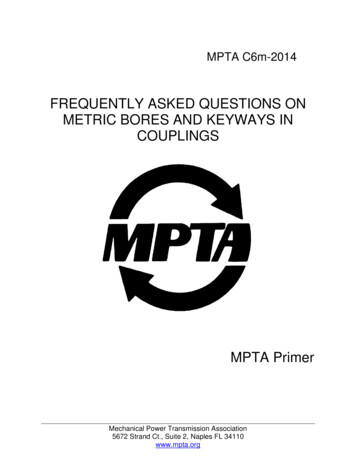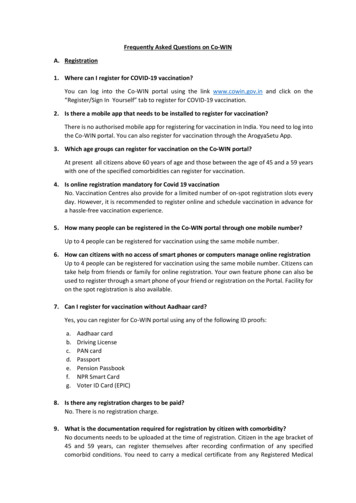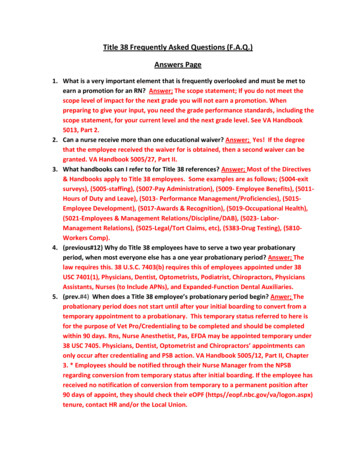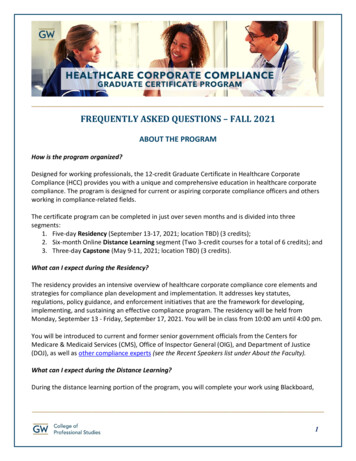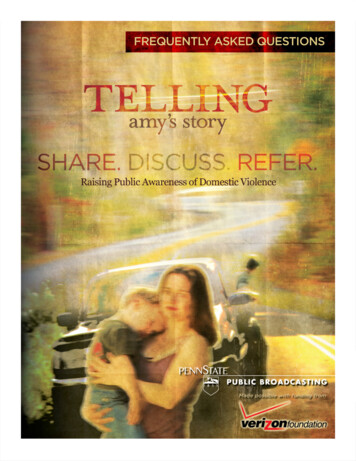
Transcription
FREQUENTLY ASKED QUESTIONS
FREQUENTLYASKEDQUESTIONSWhat isdomestic violence?Domestic violence is a pattern of behaviorin any intimate relationship whereby onepartner seeks to gain or maintain power andcontrol over the other.Abuse can be physical, sexual, emotional,economic, and psychological. The abusertakes action or makes threats that influencethe other person. This includes anybehaviors that frighten, intimidate,terrorize, manipulate, hurt, humiliate,blame, injure, or wound someone.Domestic violence can happen to anyone ofany race, age, sexual orientation, religion,and gender. It can happen with couples whoare married, living together, or dating.Domestic violence affects people of allsocioeconomic backgrounds and educationlevels.(Adapted from National DomesticViolence Hotline)1 Bureau of Justice Statistics (Feb. 2003).Crime Data Brief, Intimate PartnerViolence, 1993-2001.2 Extrapolated from the National ViolenceAgainst Women Survey (NVAWS) and U.S.Census population. Centers for DiseaseControl and Prevention, National Centerfor Injury Prevention and Control (2003).Costs of Intimate Partner Violence AgainstWomen in the United States. Atlanta, GA.How prevalentis domestic violence?According to a 2008 study by the Centers for DiseaseControl and Prevention, about ¼ of all womenin the U.S. report that they have experienceddomestic violence.On average, more than 3 women are murderedby their husbands or boyfriends in this countryevery day.1Nearly 7.8 million women have been raped by anintimate partner at some point in their lifetime.21 in 3 women worldwide has been beaten, coerced intosex, or otherwise abused.31 in 5 female high school students reportsbeing physically and/or sexually abused bya dating partner. Abused girls are significantlymore likely to get involved in other risky behaviors.They are 4 to 6 times more likely to get pregnantand 8 to 9 times more likely to attempt suicide thantheir non-abused peers.41 in 3 teens report knowing a friend or peerwho has been hit, punched, slapped, choked,or otherwise physically hurt by his/her partner.53 Silverman, J.G., Raj, A., and Clements,K. (2004). Dating Violence and associatedsexual risk and pregnancy amongadolescent girls in the United States.Pediatrics, 114(2): e220-e225.4 These are findings from a studycommissioned by Liz Claiborne Inc. toinvestigate the level of and attitudestowards dating abuse among Americanteenagers aged 13 to 18. Teenage ResearchUnlimited (TRU). (2005).Teen Dating Abuse Survey. Available tm5 Gazmararian, J.A., Petersen, R., Spitz,A.M., Goodwin, M.M., Saltzman, L.E.,and Marks, J.S. (2000) Violence andreproductive health; current knowledgeand future research directions. Maternaland Child Health Journal, 4(2): 79-84.Domestic Violence Toolkit // Frequently Asked Questions // 2
// FREQUENTLY ASKED QUESTIONS //Where do you go for help?Why do victims stay?The National Domestic Violence Hotline (NDVH)provides anonymous and confidential help.The NDVH is a nonprofit organization that providescrisis intervention, information, and referrals tovictims of domestic violence, perpetrators, friends,and families.LoveAbusers are not hurtful all the time. Many abusershave a likable and loving side. Many victims thinkthat they can change the abuser’s behavior.1-800-799-7233 (SAFE)Hotline Services: Crisis intervention, safety planning, informationabout domestic violence, and referrals to localservice providers Direct connection to domestic violence resourcesavailable in the caller’s area provided bya Hotline advocate Assistance in both English and Spanishwith Hotline advocates who have accessto more than 170 different languagesthrough interpreter servicesFearMany abusers threaten to hurt or kill themselvesif their victim decides to leave. Abusers often threatenthat the violence will get worse if the partner decidesto leave.DoubtIt’s not always easy for a victim to admit that therelationship is abusive. If the victim’s partner isespecially popular at school or in the community, thevictim may be concerned about losing social status. Assistance through e-mailEmbarrassmentVictims can be afraid of an “I told you so” responsefrom those who have tried to help in the past. Informational materials on such topics asdomestic violence, sexual assault, batteringintervention and prevention programs,working through the criminal justice system,and related issuesHope for ChangeVictims often believe that the abuser will return to theperson he was at the beginning of the relationship—the person she fell in love with.What will a domestic violenceadvocate do? Listen Support your decisions Not blame you Help in a way that is best for youHow can a domestic violenceadvocate help? Create a safety plan Navigate law enforcement Arrange for shelter Get information and referrals to local resources Advocate for you through the judicial system Set up regular counselingIsolationAs a tactic of the abuse, the abuser is likely to havemade it difficult for the victim to access resourcesand supportive people.Societal DenialAbusers often have a public face that is charming andcharismatic; it is difficult for those who only knowthat side to believe that abuse is taking place.Societal ExpectationsThe victim may see ending the relationship as a failureand may also fear social stigma. The victim may not fitstereotypes about victims of domestic abuse.Lack of ResourcesIt may be difficult or impossible for the victim tocontact supportive people, and she may not havemoney or any way to find housing. Connect with a support groupDomestic Violence Community Toolkit // Frequently Asked Questions // 3
// FREQUENTLY ASKED QUESTIONS //Economic AutonomyThe number one indicator that a victim will be able toleave is economic stability outside of the relationship.ChildrenThe victim may believe that it is better for a child ifthe parents are together. The victim may not want todisrupt childcare or schooling arrangements.(Adapted from Centre County Women’sResource Center)What can you say? I believe you. You are not alone. No one deserves to be abused. It can be difficult to know what to do.What are some signsof domestic violence?Look for Physical signs of injury Signs of anxiety and fear Emotional distress Isolation Change in appearance and self-esteem Restricted transportation Clothing that is inappropriate for the season Attempts to hide activities or interactionsfrom partner Minimization and denial of harassment or injuries(Centre County Women’s Resource Center) It can feel overwhelming at times.What does an abuser look like? It’s ok to still love him/her but not like what’shappening.Abusers come from all walks of life. Much like victims,you cannot identify an abuser by where he lives,or what he does for a living. Abusers are unemployedworkers, farmers, computer experts, car salesmen,university professors, truck drivers, psychiatrists,and teachers—everyone. Abusers are therefore noteasy to identify. I am concerned for your safety. Leaving can be a very dangerous time. There are options available. Abuse is often about power and control. I’ve noticed you’ve been late, absent, tired,different lately, I’m concerned. You know your situation best. It’s important for you to make the decisionthat is best for you. The local domestic violence programmay be able to help with a safety plan. The local domestic violence programmay be able to explore options with you.Some helpful things to do Listen Respect privacy and confidentiality Respect her choices Encourage her to seek professional resources Validate feelings(Centre County Women’s Resource Center andNational Domestic Violence Hotline)Signs of an abuser:JealousyAt the beginning of a relationship, an abuserwill say that jealousy is a sign of love.Controlling BehaviorThe abuser is likely to disguise or excusecontrolling behavior.Quick InvolvementMany victims of abuse dated or knew their abuser forless than six months before they became engagedor started living together.Unrealistic ExpectationsThe abuser may expect the victim to be the perfectspouse/parnter, parent, lover, and friend.He depends on the victim for all his needs, and mayalso state that he can fulfill all of the victim’s needsfor a lover, friend, and companion.Domestic Violence Community Toolkit // Frequently Asked Questions // 4
// FREQUENTLY ASKED QUESTIONS //IsolationThe abuser may try to curtail the victim’s socialinteraction and may prevent her from going to workor class or being with friends and family.victim, people in other relationships can be victims.Same-sex relationships and male-female relationshipshave similar rates of domestic violence.(Adapted from Centre County Women’sResource Center)Blame-Shifting for ProblemsVery rarely will an abuser accept responsibility for anyproblem or negative situation.Heterosexual males can also be victims of domesticviolence perpetrated by their female partners.They experience the same dynamics of interpersonalviolence, including experiences of disbelief, ridicule,and shame that only reinforce their silence. However,members of some cultural groups are at higher riskof domestic violence than the general population.(Adapted from The National DomesticViolence Hotline)Verbal AbuseThe abuser may say things that are meant to be cruel,hurtful, and degrading, either in public or in private.He may also downplay the victim’s accomplishments.Any Force During an ArgumentAn abuser may physically restrain the victim fromleaving the room, lash out at the victim with his/herhand or another object, pin the victim against a wallor shout “right in her face.”(Adapted from Centre County Women’sResource Center)Are children hit too?Studies show that children are physically abused inapproximately half the families where the mother isa known victim of domestic assault. Similarly, themother is being battered in approximately half thefamilies where her child is a known victim of physicalabuse.6Can domestic violencehappen to anyone?Victims and abuser are of every race, age,socioeconomic status, sexual orientation, mentalor physical ability, occupation, education, andreligious background. Women can be abused inany neighborhood in any town. Victims are factoryworkers, nurses, lawyers, homemakers, police officers,and students. They are grandmothers and teenagers.Approximately 50% of all couples experience domesticviolence at some time in their lives.(National Domestic Violence Hotline and CentreCounty Women’s Resource Center)Are men also victimsof domestic violence?The effect on childrenwho are not abused 15.5 million U.S. children live in families in whichpartner violence occurred at least once in the pastyear, and seven million children live in families inwhich severe partner violence occurred.7 Children who experience childhood trauma,including witnessing incidents of domesticviolence, are at a greater risk of having seriousadult health problems including tobacco use,substance abuse, obesity, cancer, heart disease,depression and a higher risk for unintendedpregnancy.8Although the “norm” of domestic violencerelationships is a male perpetrator and a female6 Edleson, J.L. (1999). The Overlap Between Child Maltreatment andWoman Abuse. National Online Resource Center on Violence AgainstWomen. Available at http://new.nawnet.org/category/Main Doc.php?docid 3897 McDonald, R., Jouriles, E.N., Ramisetty-Mikler, S., and Caetano,R. (2006) Estimating the number of American children living inpartner-violent families. Journal of Family Psychology 20(1): 137-142.8 Felitti, V.J., et al. (1998). Relationship of childhood abuse andhousehold dysfunction to many of the leading causes of death inadults: The Adverse Childhood Experiences (ACE) Study. AmericanJournal of Preventative Medicine, 14(4): 248-58. Centers forDisease Control and Prevention and the Kaiser Permanente’s HealthAppraisal Clinic, San Diego, CA. Available at http://www.cdc.gov/NCCDPHP/ACE/index.htmDomestic Violence Community Toolkit // Frequently Asked Questions // 5
On average, more than 3 women are murdered by their husbands or boyfriends in this country every day.1 Nearly 7.8 million women have been raped by an intimate partner at some point in their lifetime.2 1 in 3 women worldwide has been beaten, coerced into sex, or othe

